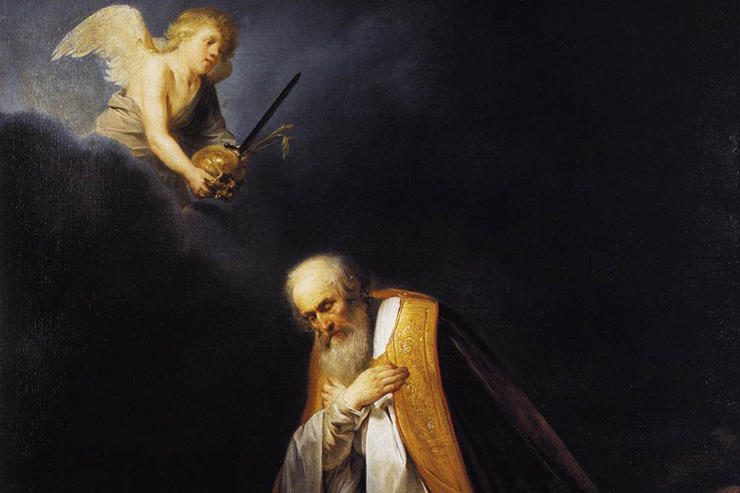Allegri’s Miserere
by Steven Jonathan Rummelsburg | October 21, 2015 12:04 am
 [1]
[1]“King David in Prayer (detail)” by Pieter de Grebber
Gregorio Allegri (1582-1652) was an Italian priest and composer of the Roman School of composers. Allegri’s masterpiece was composed in 1638 for an annual celebration during Holy Week. It was two times during Holy Week, on Wednesday and Friday during a 3:00 a.m. service, that twenty-seven candles were extinguished one at a time until there remained a single lit candle. It was said that the Holy Father would participate in these services and Allegri composed the Miserere to be performed at the end of the Tenebrae services and the pope would kneel and pray at the altar with the single remaining burning candle. This must have been a holy, solemn and beautiful moment to behold.
There were many versions of the Miserere written, first by Costanzo Festa as early as 1518. Ten more composers including Guerrero and Palestrina also proffered their own versions of this sorrowful psalm, but Allegri’s stirring rendition overshadowed the rest until it became the only rendition used and it remains with us today. It became such a prized possession of Holy Mother Church that there was a prohibition of its performance outside the Sistine Chapel and under the pain of excommunication it was forbidden to copy it. Nonetheless, by 1770 there were at least three copies known to exist, one by Padre Giovanni Battista Martini (1706-1784), the King of Portugal and another copy said to be housed in the Imperial Library in Vienna.
Throughout the years there have been many interesting and alluring stories concerning its performances and peregrinations. However, none is quite so intriguing as the story of a twelve-year-old Mozart. In December of 1769, Leopold and Wolfgang Mozart left their hometown of Salzburg for a fifteen month tour of Italy where they came across none other than Padre Giovanni Martini, known also for having taught Johann Christian Bach. Young Wolfgang went to Bologna to be taught by Padre Giovanni as well. In April of 1770, the Mozarts visited St. Peter’s Basilica to celebrate the Wednesday Tenebrae. They wanted to hear the famous Miserere performed at the Sistine Chapel. The youthful Mozart was so moved by the Miserere that when he returned to his accommodations that evening he wrote out the entire manuscript from memory. On Good Friday, he went again to the service to hear it again and make minor corrections to his manuscript. Wolfgang’s father Leopold wrote of this achievement to his wife on April, 14, 1770 from Rome:
“…You have often heard of the famous Miserere in Rome, which is so greatly prized that the performers are forbidden on pain of excommunication to take away a single part of it, copy it or to give it to anyone. But we have it already. Wolfgang has written it down and we would have sent it to Salzburg in this letter, if it were not necessary for us to be there to perform it. But the manner of performance contributes more to its effect than the composition itself. Moreover, as it is one of the secrets of Rome, we do not wish to let it fall into other hands….”
There is a mysterious twist to the end of this tale. It turns out that Mozart’s manuscript of the Miserere has never been found and it can be supposed that it would have been very informative concerning the style and creativeness employed by the papal choir in 1771. However, there is a famous music historian named Dr. Charles Burney who made a tour of Italy around the same time Mozart returned to study with Padre Martini. Though we know practically nothing of the interaction, Dr. Burney met with Wolfgang in Bologna with Padre Martini. When Dr. Burney returned from his tour he published a collection of music used during Holy Week in the Sistine Chapel and included was a rendition of Allegri’s Miserere. Since then it has been copied many times and in many places.
Allegri’s Miserere remains one of the most recorded pieces of music in Church History and after listening to it several times, it is easy to recognize why. It is a haunting call to repentance in recognition of the misery of human frailty in the face of God’s call to sanctity. Listen to this and recall Psalm 51 where David pleas for forgiveness for his sins:
“Have mercy on me, O God, according to thy steadfast love; according to thy abundant mercy blot out my transgressions… For I know my transgressions, and my sin is ever before me. Against thee, thee only, have I sinned…The sacrifice acceptable to God is a broken spirit; a broken and contrite heart… Behold, thou desirest truth in the inward being; therefore teach me wisdom in my secret heart. Purge me with hyssop, and I shall be clean; wash me, and I shall be whiter than snow.”
Watch and listen below… and weep. Listen as you contemplate the chasm that exists between the misery of man and the heart of God. Listen as you ponder how God’s mercy towards sinners bridges that chasm. Notice too how the words misery and heart come together in the Latin word Misericordia—denoting the misery of man’s condition redeemed by the infinite ocean of mercy that is God’s heart. “Blessed are those who mourn for they shall be comforted.” As we sorrow for our own sins and the sins of the world, let Allegri’s timeless masterpiece carry us to a more profound understanding of this vale of tears as we may encounter God’s unfathomable mercy.
[youtube id = “nKj1iK2WKS8”]
- [Image]: http://www.integratedcatholiclife.org/wp-content/uploads/king-david-in-prayer-pieter-de-grebber-detail-w740x493.jpg
Source URL: https://integratedcatholiclife.org/2015/10/rummelsburg-allegris-miserere/